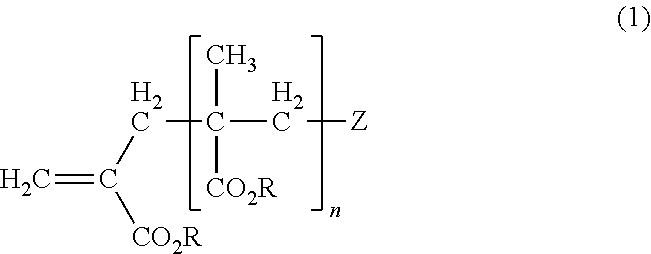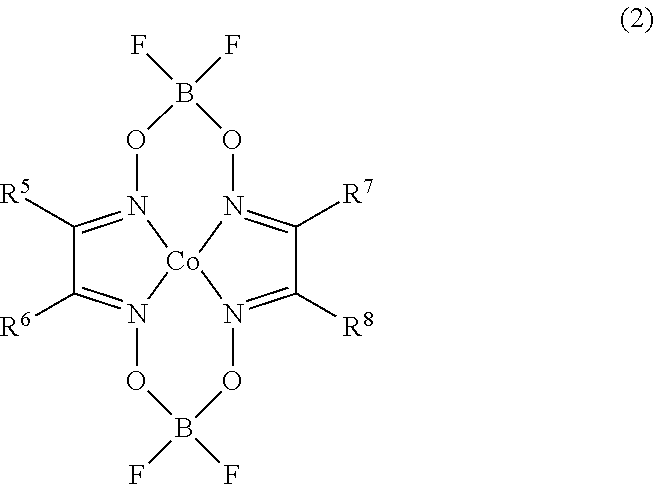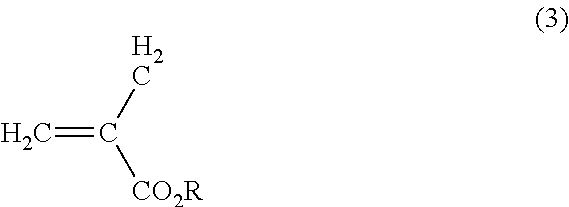Modifier for polyvinylidene fluoride, binder resin composition for battery, electrode for secondary battery and battery
a technology of polyvinylidene fluoride and binder resin, which is applied in the direction of active material electrodes, cell components, electrochemical generators, etc., can solve the problems of easy peeling off of electrode active materials from collectors, difficult composite of pvdf with other materials, and inability to meet the requirements of specific solvents, etc., to achieve enhanced adhesion of pvdf to metal, excellent effects, and reduced excellent characteristics
- Summary
- Abstract
- Description
- Claims
- Application Information
AI Technical Summary
Benefits of technology
Problems solved by technology
Method used
Image
Examples
preparation example 1
Synthesis of Metal Chain Transfer Catalyst (diaquabis(boron difluorodiphenyl glyoximato)cobalt(II); CoBF)
[0088]0.5 g of cobalt acetate tetrahydrate and 1.0 g of diphenylglyoxime were placed in a 100 mL three-necked flask, and were dissolved by adding 20 mL of ether which had been deaerated under a nitrogen atmosphere. A resulting mixture was stirred at room temperature for 2 hours.
[0089]Then, 4 mL of boron trifluoride-diethyl ether complex was added thereto and the mixture was further stirred at room temperature for 12 hours. The mixture was filtered, and a resulting solid was washed with ether and dried in a vacuum dryer at room temperature for 24 hours, thereby obtaining a reddish brown solid.
[0090]As a result of the 1H-NMR measurement and an elemental analysis, it was confirmed that the resulting solid had a structure in which R5˜R8 in the general formula (2) are phenyl groups.
preparation example 2
Synthesis of Macromonomer (A1)
[0091]1000 g of methyl methacrylate (MMA), 2000 g of water, 26.7 g of 3.5% sodium 2-sulfoethyl methacrylate / potassium methacrylate / methyl methacrylate copolymer aqueous solution as a dispersing agent, 13.3 g of sodium sulfate, and 0.01 g of the CoBF obtained in Preparation Example 1 were added to a 5 L separable flask having stirring blades, a thermometer and a cooling pipe, and were stirred at 300 rpm under a nitrogen atmosphere.
[0092]5.0 g of 2,2′-azobis(2,4-dimethylvaleronitrile) (trade name: V-65, manufactured by Wako Pure Chemical Industries, Ltd.) as a polymerization initiator was added, and the mixture was heated to and maintained at 60° C. until polymerization heat generation was observed. After identifying a peak value of the polymerization heat generation, the mixture was heated to 70° C. and maintained at the temperature for 30 minutes, and then was cooled to room temperature.
[0093]The mixture was filtered, and a resulting solid was washed wi...
preparation example 3
Synthesis of Macromonomer (A2)
[0094]The macromonomer (A2) was obtained by the same method as in Preparation Example 2 except that the amount of the CoBF was changed to 0.04 g. The macromonomer (A2) was a mixture of two MMA macromonomers and had a structure in which R is methyl group and Z is —C(CH3)(CN)—CH2—CH(CH3)2 or methyl group in the general formula (1). The macromonomer (A2) had Mn of 4,000, Mw of 7,000, and double-bond introduction ratio of 68 mol %.
PUM
| Property | Measurement | Unit |
|---|---|---|
| thickness | aaaaa | aaaaa |
| width | aaaaa | aaaaa |
| length | aaaaa | aaaaa |
Abstract
Description
Claims
Application Information
 Login to View More
Login to View More - R&D
- Intellectual Property
- Life Sciences
- Materials
- Tech Scout
- Unparalleled Data Quality
- Higher Quality Content
- 60% Fewer Hallucinations
Browse by: Latest US Patents, China's latest patents, Technical Efficacy Thesaurus, Application Domain, Technology Topic, Popular Technical Reports.
© 2025 PatSnap. All rights reserved.Legal|Privacy policy|Modern Slavery Act Transparency Statement|Sitemap|About US| Contact US: help@patsnap.com



